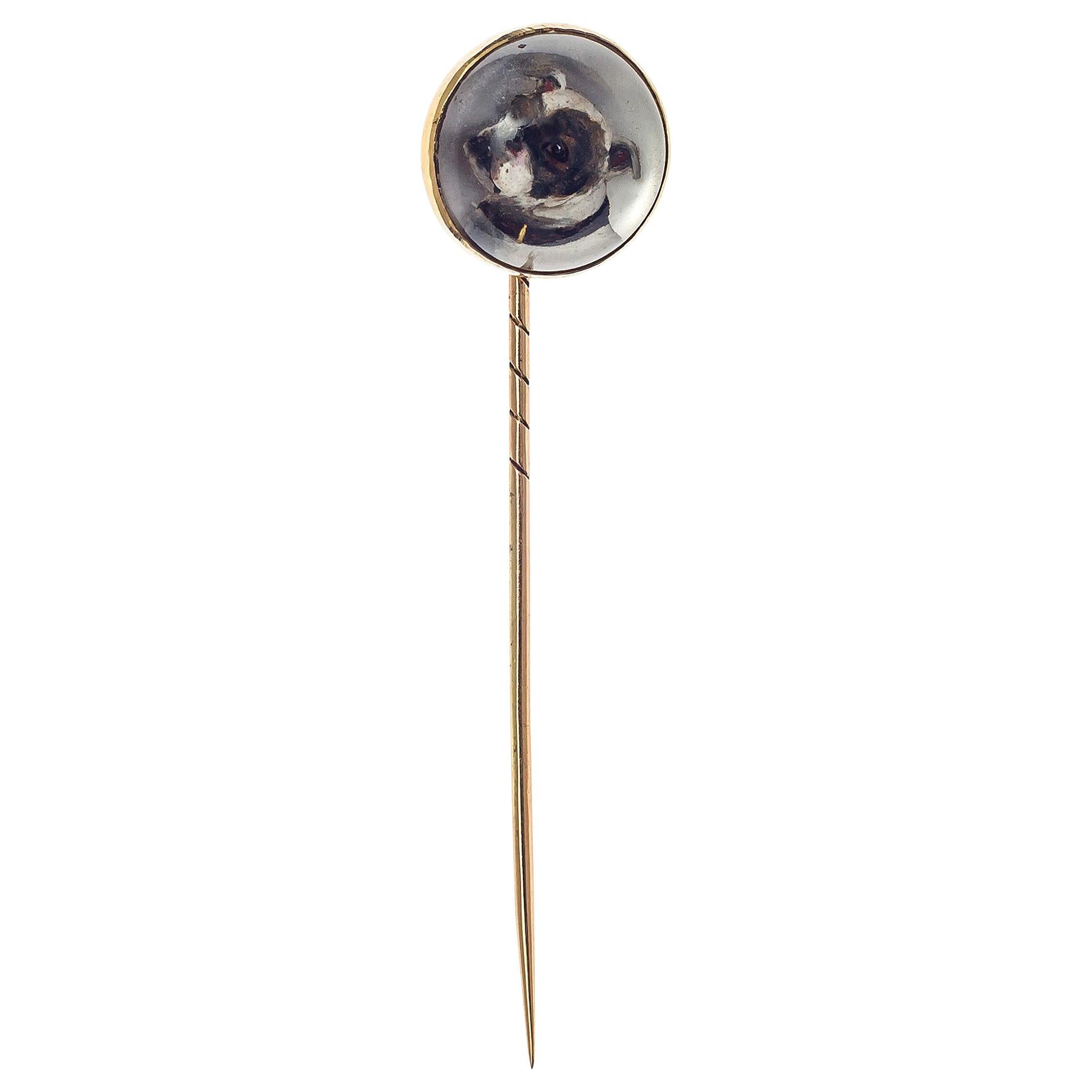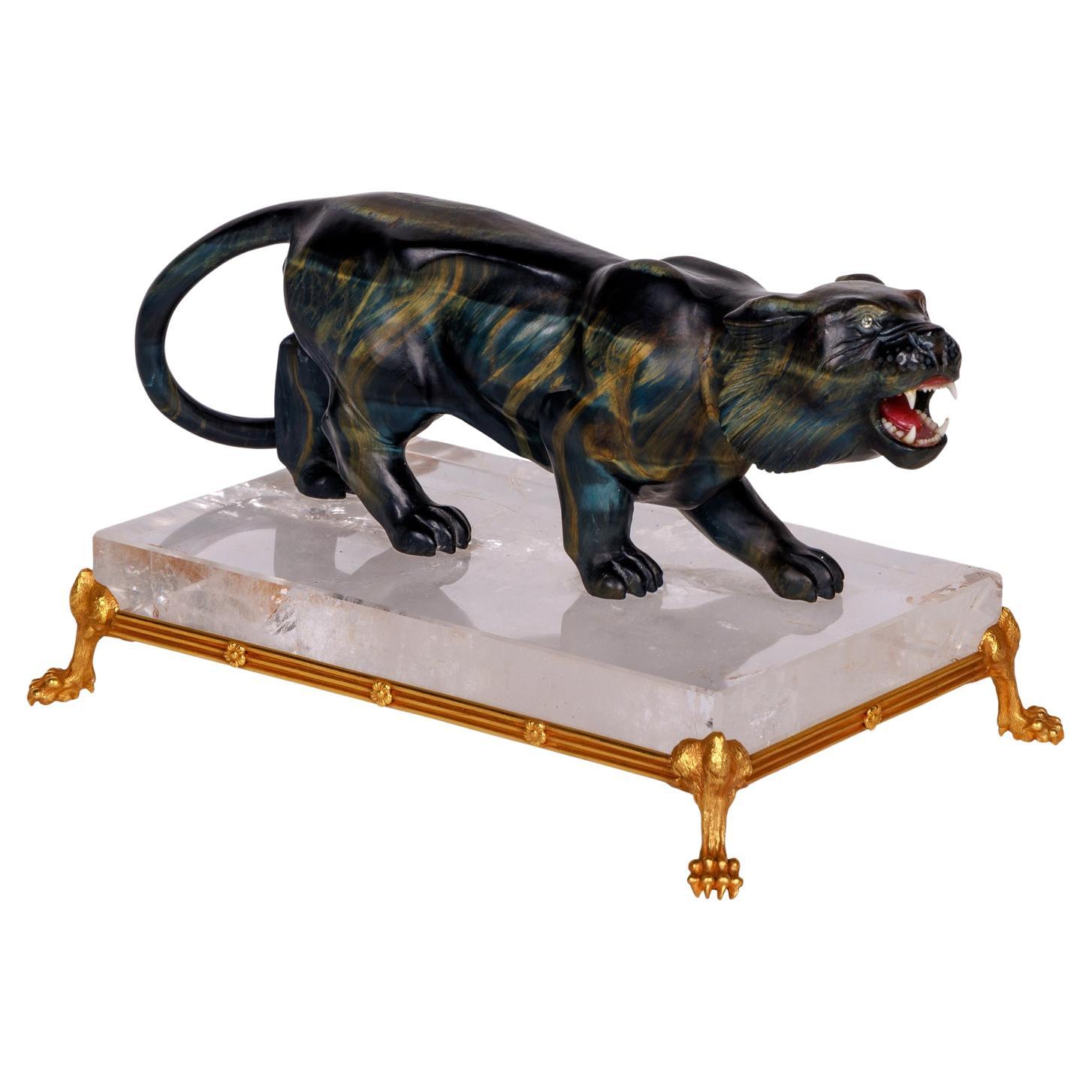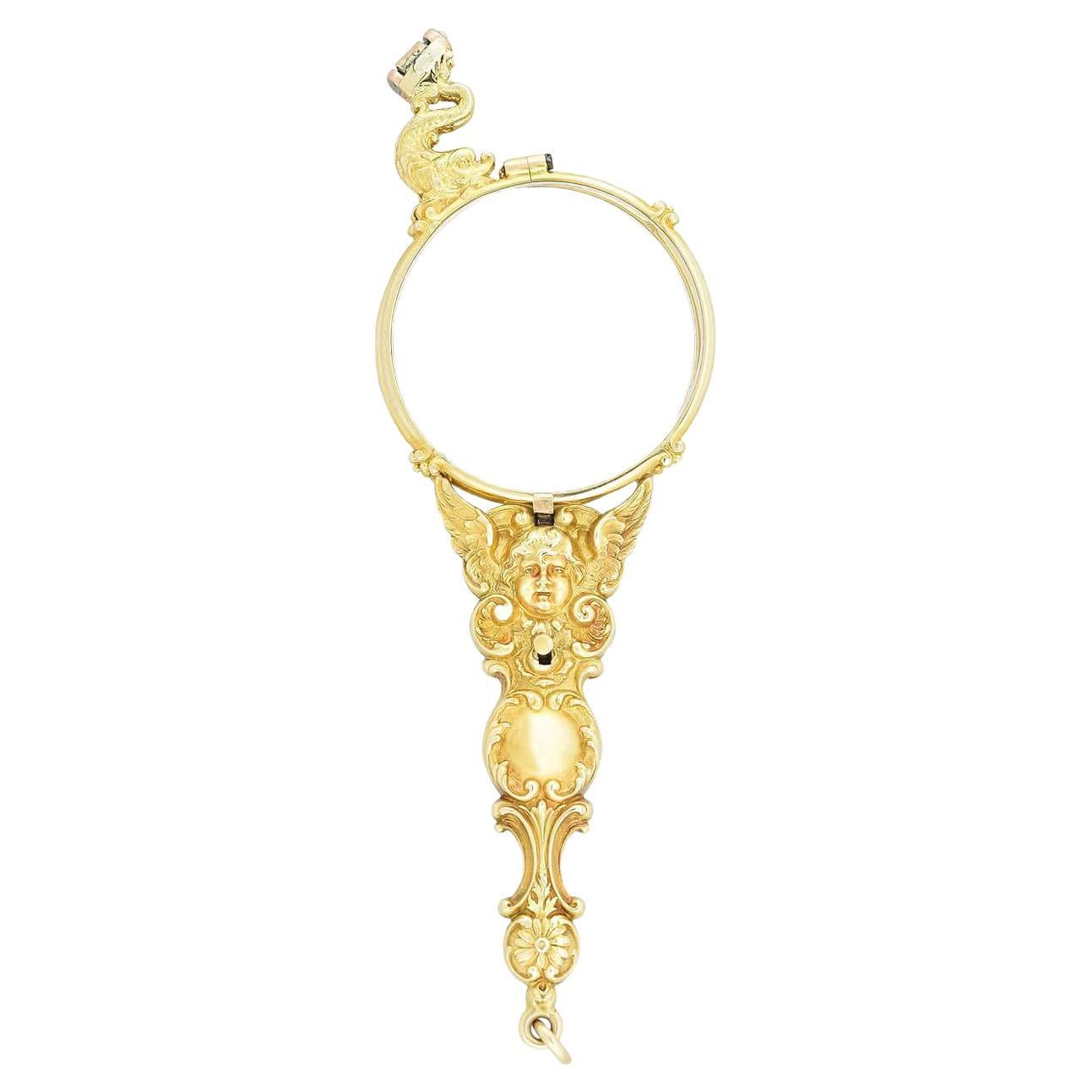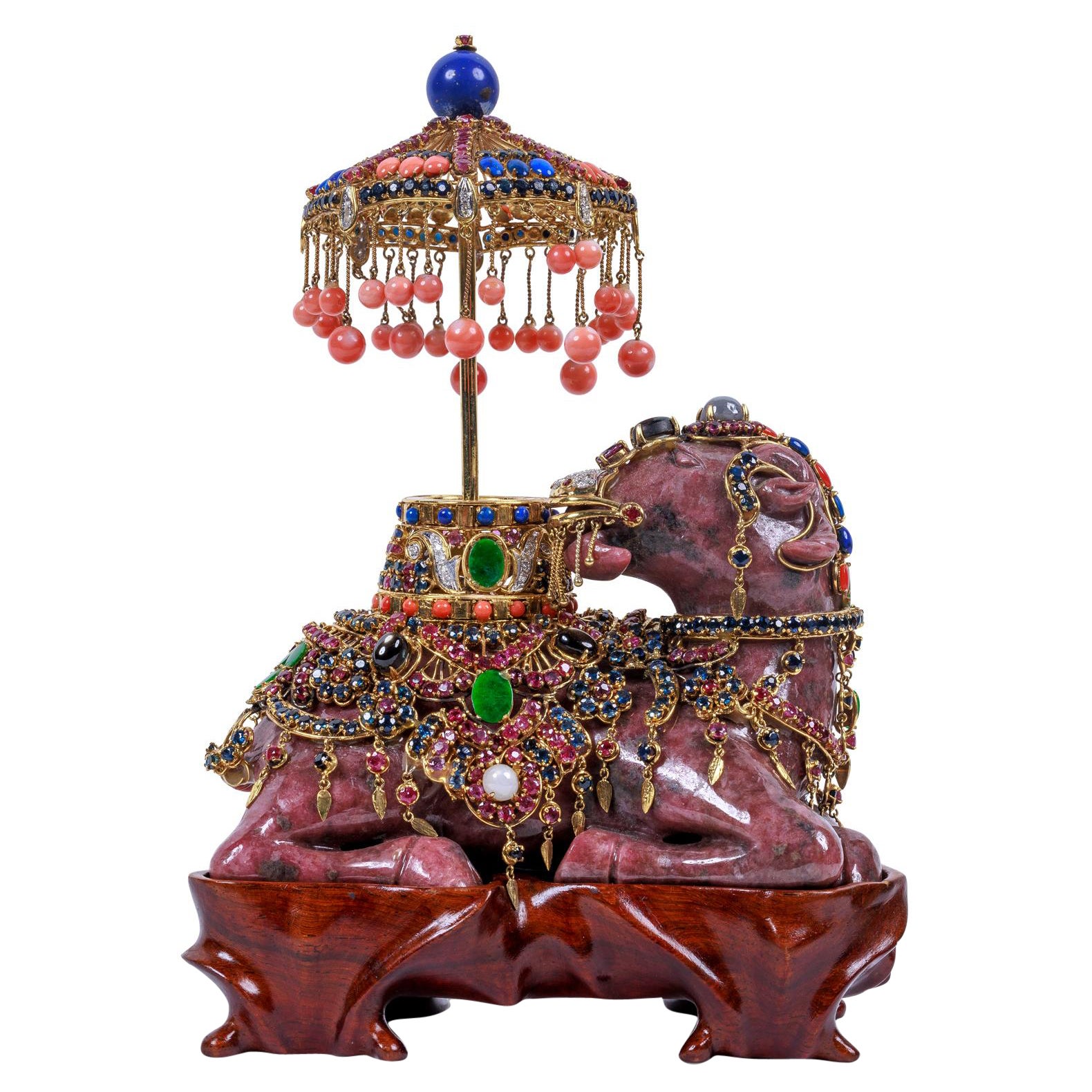Items Similar to Antique Reverse Crystal Stickpin Tiepin Boxer Dog 14kt Red Gold Red Dog Collar
Want more images or videos?
Request additional images or videos from the seller
1 of 6
Antique Reverse Crystal Stickpin Tiepin Boxer Dog 14kt Red Gold Red Dog Collar
About the Item
This reverse crystal of a boxer dog wearing a red dog collar has been hand carved and hand painted in the last quarter of the 19th century. The crystal is mounted in a red gold setting and impressed with the Austrian hallmark for 14 karat gold and the initials LP for the jeweller.
- Metal:
- Stone:
- Stone Cut:
- Weight:4.16 g
- Dimensions:Width: 0.4 in (10 mm)Depth: 0.32 in (8 mm)Length: 2.96 in (75 mm)
- Style:
- Place of Origin:
- Period:
- Date of Manufacture:1890
- Condition:Wear consistent with age and use.
- Seller Location:Munich, DE
- Reference Number:1stDibs: LU1490118407772
About the Seller
4.9
Platinum Seller
These expertly vetted sellers are 1stDibs' most experienced sellers and are rated highest by our customers.
1stDibs seller since 2019
138 sales on 1stDibs
Typical response time: 4 hours
- ShippingRetrieving quote...Ships From: Munich, Germany
- Return PolicyA return for this item may be initiated within 3 days of delivery.
More From This SellerView All
- Antique Carved Childs Head Corallum Rubrum Gold Stickpin TiepinLocated in Munich, BavariaThis charming stickpin of a child's head has been handcarved in the first third of the 19th century.Category
Antique 1820s Italian Figurines and Sculptures
MaterialsGold, 14k Gold, 9k Gold
- Antique Victorian English Essex Crystal Gold Dog Pug StickpinLocated in Munich, BavariaThe wonderful carved Essex Chrystal stickpin of a pug is mounted in gold. The reverse carved ad painted crystal has been executed in England in 1865 ca. The pug wears a collar with a...Category
Antique 1860s Victorian More Jewelry
MaterialsCrystal, 15k Gold
- 1890 Belle Èpoque Dog Yorckshire Terrier Stickpin 18 Kt Platinum Diamond RubyLocated in Munich, BavariaNaturalistically modelled stickpin of a dog of outstanding quality, possibly a Yorckshire Terrier. The lovely animal has with ruby eyes, a golden snout and a pink enamelled tongue. I...Category
Antique 1880s French Belle Époque More Jewelry
MaterialsDiamond, Platinum, Enamel
- Antique Opal Silver Stickpin Tiepin of a GnomeLocated in Munich, BavariaThis unusual stickpin features a bearded gnome with a hood. Under his right arm he is holdig an opal and he raises the finger of his left hand.Category
Antique 1880s Victorian More Jewelry
MaterialsOpal, Silver
- Antique Gold Sword Fighter Shield Warrior Turquoise Cabochon Stickpin TiepinLocated in Munich, BavariaAntique stickpin of a sportsman or a warrior holding a sword in his right hand and shield with hos left arm.Category
Antique 1890s More Jewelry
MaterialsTurquoise, 14k Gold
- Antique Art Deco Horse Shoe Good Luck Diamond Platinum 14k Gold Stickpin TiepinLocated in Munich, BavariaThis elegant horseshoe stickpin promises good luck to its wearer, understated elegance thanks to the delicate design, executed in platinum and set with diamonds. The pin is made out...Category
Vintage 1920s Art Deco Vanity Items
MaterialsDiamond, Gold, 14k Gold, Platinum
You May Also Like
- Rare Carved Hawk's Eye Agate Tiger on a 14K Gold Mounted Rock Crystal BaseLocated in New York, NYA rare carved Hawk's Eye agate tiger on a 14k gold mounted rock crystal base, circa 1960. "A Jeweled Sculpture" An incredible carved tiger made fro...Category
20th Century Figurines and Sculptures
MaterialsAgate, Rock Crystal, 14k Gold
- Art Nouveau 14kt Expandable Lorgnette GlassesLocated in Narberth, PAA spectacular lorgnette from the Art Nouveau (ca1900) period! Crafted in 14kt yellow gold, the piece consists of a pair of folding glasses encased in a breathtaking repousse lorgnett...Category
Antique Early 1900s Unknown Art Nouveau Necklace Enhancers
Materials14k Gold
- Exquisite 14K Gold, Diamonds, Emeralds, Rubies, Semi Precious Stone CamelLocated in New York, NYAn Exquisite 14K Gold, Diamonds, Emeralds, Rubies, Sapphires, and Semi Precious Stone Mounted Rhodonite Camel. Circa 1970, Italy A very good quality and unusual gold mounted jeweled object...Category
20th Century Italian Figurines and Sculptures
MaterialsCoral, Diamond, Emerald, Moonstone, Pearl, Ruby, Blue Sapphire, 14k Gold
- Mellerio Paris, a French Gold, Diamond, Silver-Gilt, Rock-Crystal, & Lapis HorseBy Mellerio ParisLocated in New York, NYMellerio Paris, A French Gold, Diamond, Silver-Gilt, Rock-Crystal, Obsidian & Lapis Horse An extremely rare and unique, one of a kind French gold, diamonds, Silver-gilt rock-crystal, obsidian and lapis lazuli jeweled sculpture "Bucéphale, Chevaux de légende", "Bucephalus, A Legendary Horse" by Mellerio, Paris, circa 1998. Sitting on black obsidian base, the solid rock crystal slab is finely applied with a lapis lazuli half-horse with harness mounted in 18k gold and brilliant cut diamonds, between two crystal and lapis lazuli columns adorned with gold and diamonds, insert with 7 ruby cabochons and 1 emerald cabochon, the obsidian base with a plaque engraved: CHEVAUX DE LEGENDE / MELLERIO DITS MELLER / PARIS / 5029 DIV Bucephalus (c355-326 BC) is among the most famous horses in history, and it was said that this he could not be tamed. The young Alexander the Great, of course, tamed him – and went on to ride his beloved equine companion for many years and into many battles. The piece is in excellent condition and comes with a custom made wood case made for transport. It's very elegant and has French hallmarks throughout. A truly magnificent piece. Measures 10" high x 9" wide x 4" deep Founded in France in 1613 by the descendants of Italian immigrants from the Vigezzo Valley in the north of Italy, Mellerio is one of the oldest jewellery houses in Europe. The family business soon attracted the attention of the Royal Court and Marie Antoinette herself reportedly purchased a precious bracelet featuring 7 cameos surrounded by rubies in 1780. Later on, in the 19th century, Mellerio became the official supplier of the French Royal family and the Court of Netherland. Mellerio creates many jewellery items, all set with rare gems such as peridots, amethysts, aquamarines, citrines and topaz, applying for a patent, the flexible stem, a very supple and light jewellery mechanism. Mellerio remains also well known for their spectacular series of Art Nouveau jewels, created at the beginning of the 20th century, as well as for the creation of trophies rewarding some of the greatest footfall and tennis players of history. In 1993, the jewellery house launched their first watch collection. Today, Mellerio has stores in Paris, Japan and Hong Kong. July 14, 1789: this date is known throughout the world as the beginning of the French Revolution. According to a ledger belonging to House of Mellerio, this was also the day that the jeweler sold a golden key to the Comte de Coutance for 10 livres. This ledger, as well as inventories dating as far back as 1768, are the jeweler’s oldest archives. These archives have continued to grow over the years, as the House, established on rue de la Paix in Paris, still lives on today, still in the hands of the same family from Craveggia, in the North of Italy. The tumultuous history of the Mellerio family in France probably goes as far back as the Italian wars of the Renaissance, but the first official document proving their commercial activity in Paris dates back to 1613. This document is the famous royal warrant awarded by Marie de Medici to a number of Italian families established along the rue des Lombards, including the Mellerios, allowing them to sell “small jewelery items”, therefore granting them a small exception to the traditional monopoly enjoyed by Parisian jewelers. At that time, powerful corporations regulated the operations and customs of Parisian business, but thanks to this exceptional warrant, the Mellerios managed to escape the confines of this framework. Today, this wax-sealed document is kept at the city hall of Craveggia. From 1613 to the Revolution, the Mellerios lived between France and Italy. The corporations tried many times to put an end to their trade privileges, but all in vain, as a dynasty of sovereigns renewed the warrant. Always marrying and often retiring in Craveggia, the Mellerios continued to maintain their jewelry business in Paris. At first, they did this without a shop. Wearing backpacks (wooden boxes divided into small compartments where jewels were kept), they would tour town fairs around Paris and royal castles. This is how Jean-Baptiste Mellerio (1765-1850) is said to have sold a bracelet set with rubies and Antique cameos to Marie-Antoinette, which still exists today. Many elements seem to prove the veracity of this anecdote. The queen was particularly fond of cameos, which cover the entire background of her famous jewelry cabinet, and ruby was her favorite stone after diamond. The famous bracelet, reacquired a few years ago by the House of Mellerio, is indeed an 18th century jewel, set with antique cameos representing the profiles of Roman emperors. Two branches of the family were operating in Paris during this time, under the reign of Louis XVI: that of Jean-François (1746-1828), the paternal ancestor of the current Mellerios, and that of Jean-Baptiste (1765-1850). The French Revolution forced them to return to Italy. However, both Jean-Baptiste and François Mellerio (1772-1843), who was the son of Jean-François, were eventually able to return to Paris after the founding of the Consulate. Jean-Baptiste opened a shop at the Iron Crown of rue Vivienne, and François opened his at the Palais des Tuileries, rue du Coq Saint-Honoré. His well-organized order books give an idea of his high-ranking clientele during the “Old Regime”, among which were the Comte and Comtesse Octave de Segur, the Marquise (later Duchess) de Tourzel, former governess of the royal children, and her daughter, the Comtesse de Bearn, the Craufurds -who organized the flight to Varennes, the Duc and Duchess de Gramont, the Comtesse de Boigne, and Madame de Souza, Talleyrand’s mistress. We also see the names of the imperial family: Empress Josephine, the Queen of Holland, Princess Elisa, Caroline and Pauline. At that time, the House of Mellerio specialized, among other things, in the trade of antique cameos, a newly fashionable genre of jewel that captured the imagination of all the princesses and noble women of the time. The years of the Restauration and July Monarchy were among the most glorious. The Bourbons were back on the throne, and the clientele of the House of Mellerio had regained its former wealth. Mellerio supplied Louis-Philippe, Duke of Orléans, as well as his mother, wife and sister, with sumptuous jewels, including a set of emeralds made piece by piece, while the Duke of Bourbon, last prince of the House of Condé, offered diamonds to his mistress, the scheming Baronne de Feucheres, and Monsieur de LaFayette also bought cameos for one of his granddaughters. For the first time, Mellerio ventured into the world of arts in 1815, when Carlotta Grisi, a famous dancer who created Giselle, as well as an actress named Rachel, bought jewels at the Mellerio store on rue de la Paix. 1848 marked a new turning point. France once again became a Republic. François Mellerio handed the company over to his son, Jean, and the latter decided to travel to Spain to build a new clientele. He later became one of the jewelers of the royal family, and met Eugénie de Montijo, who remained a faithful client when she became empress of the French people. The Imperial years were lavish. During the Second Empire, Paris was a pageant of crinoline dresses designed by Worth, while jewels by Mellerio, Worth’s neighbour on the rue de la Paix, adorned the noble women of the Tuileries court. The Empress bought pearls. Mathilde Bonaparte...Category
21st Century and Contemporary French Figurines and Sculptures
MaterialsDiamond, Lapis Lazuli, Rock Crystal, Gold, Silver
- Horsehead Reverse Crystal Gold Money ClipLocated in Darnestown, MDNicely painted horse head under crystal makes a beautiful money clip from the mid 20th century. It is 14 karat gold. Measurements are 1 1/4 inches x 1 3/4 inches.Category
Vintage 1940s American More Objets d'Art and Vertu
Materials14k Gold
- Globe De Mariée, Marriage Crystal Dome 1880s with Love AngelLocated in Bilbao, ES1880´s An antique French Wedding Globe or Globe de Mariée Made for a Spanish client because it has a love angel with AMOR on it side. These are the mo...Category
Antique Late 19th Century French Art Nouveau Figurines and Sculptures
MaterialsCrystal, Gilt Metal
Recently Viewed
View AllMore Ways To Browse
Antique Gold Collar
14kt Cabochon
14kt Victorian
Gold Antique Dog Jewelry
Collar Setting
Antique Victorian Collar
14k Dog
D Initial Jewelry
Initial D Jewlery
Dog 14k Gold
Victorian Jewelry Collar
Antique Austrian Crystal
Victorian Gold Collar
Antique Red Crystal
Hand Painted 14k Gold
Boxer Sculpture
Crystal Reverse Paint Jewelry
Reverse Painted Crystal Jewelry





